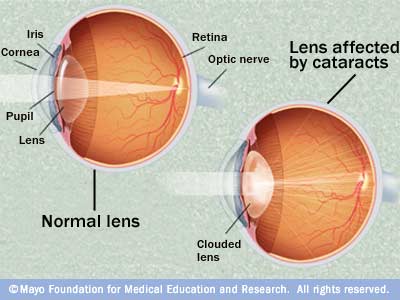Information on the Common Eye Condition: Cataracts

What Are Cataracts?
Simply stated, a cataract occurs when the lens of a person’s eye appears cloudy, in such a way that vision is negatively affected. Commonly associated with aging, some studies have shown that potentially more than half of all people over the age of eighty have either had a cataract, or will end up needing to have cataract surgery.
While cataracts can and often do occur in one or both eyes, the condition does not have the ability to travel or spread from a single eye to the other. So what exactly happens to the eye when there is a cataract? The problem is associated with the lens of the eye, which when healthy, is a clear element that assists in focusing light onto the retina, located at the back of the eyeball.
When a person has a cataract, the lens (normally clear so that light can pass through to the retina) is cloudy, and so images appear to be blurry and out of focus.
More Information to Consider With Cataracts: Types and Causes
There are several types of cataracts to consider, rather than one single condition. Traumatic cataracts often take years to develop, but typically find their origins in some kind of trauma to the eye. Congenital cataracts occur in infants or small children, though they may be so small as to not require direct treatment.
Secondary cataracts tend to occur as a result of surgical treatment to the eye, typically for another condition (such as glaucoma). Secondary cataracts have also been linked to patients suffering from other medical conditions such as diabetes. Lastly, some people who have been exposed to radiation may experience what is known as a Radiation cataract.
Because a person’s eye is composed mostly of protein and water, a crucial balance must be struck so that the arrangement of protein in the eye keeps the lens clear so that normal vision may function, as light reaches the back of the eye. Commonly associated with age, the proteins in the eye may begin to “clump together,” producing a cloudy region on the lens. As the condition progresses or is left untreated, more proteins may clump together, and the cataract may grow.
Both smoking and diabetes have been named as causes of cataracts, but researchers have also suggested that due to age-related wear on the eye, cataracts may be the result of a natural decline in the body over time.
Treatment for Cataracts in the Eye
If diagnosed early enough by a professional optometrist, then the symptoms of cataracts may be treated through normal, cost-effective and non-surgical means, like special sunglasses or more intense lighting in the room. Once the condition has progressed, however, surgery does become the only effective solution. During cataract surgery, the cloudy lens is removed and then replaced with an artificial one.
Most doctors will agree that by the time the cataract consistently interferes with normal daily activities like reading or driving, then surgery becomes a necessity. Again, when you have your vision tested regularly, especially with the onset of age, you will be in a much greater position to detect, diagnose, and treat cataracts.
When surgery is the only option, you and your doctor will likely discuss the two different types that are possible, namely Phaco (Phacoemulsification) or Extracapsular surgery. During phaco surgery, a probe is inserted into the eye through a tiny incision made along the side of the cornea. Through ultrasound waves emitted by the probe, the lens is broken up and then removed through suction. This is the more typical cataract surgery of the two. Extracapusular cataract surgery involves a longer incision along the cornea, allowing for complete removal of the clouded lens, all in a single piece. Again, suction is used to extract the remaining portion of the lens.
With regular eye examinations from a trained optometrist, symptoms are much more likely to be properly diagnosed early on.
[Diagram Via: mayoclinic.com]

